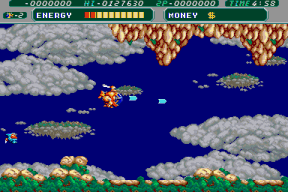
After Menace, Dave started thinking about his next game. Steve, Dave and I were all avid arcade players, and the current games of choice in our local arcade were Alien Syndrome, Quartet, and Mr. Heli. Dave loved the cuteness of Mr. Heli, and the scrolling system it used, and so this became the inspiration of Blood Money. While the game itself is nothing like Mr. Heli, the inspiration is clear to see.
Dave Started Blood Money on the 4th of January with his shiny new 25 MHz 386-DX PC, complete with a PDS (Personal Development System) that let him squirt the compiled code over to the Amiga in an instant! Psygnosis, happy with Menace, had sent Dave a new toy, and he was keen to show it off. Compared to his A1000, this system was fast…very fast. The entire code would compile almost before your finger left the keyboard – I was insanely jealous.
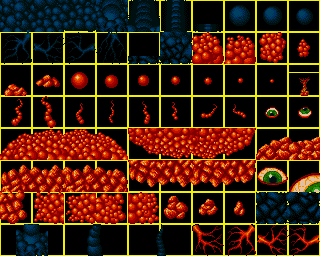
About this time I had just been “asked” to leave college for…well….not attending basically. The old computer courses weren’t very good, and not tuned to the modern world of computing, this bored me silly, and I lost interest. I spent all my time in the computing lab, and no time in classes, so it’s not a shock to see me having to leave.
Tony started doing new graphics for Dave’s new game, and these were up to his usual very high standard, while Dave started on a new scrolling system. In his the last game, Dave used the “dual playfields” mode of the Amiga, but he disliked the lack of colour.

In his new game he was determined to use the full colour range of the Amiga, so he decided to ditch the hardware scrolling, and use the Blitter to draw the screen. The Blitter was a piece of the Amiga that allowed graphics to be drawn very quickly. This method had a few unexpected advantages, the best of which meant that sprites could be drawn much quicker. This was a huge step, since he could now cover the screen in moving objects, not just four or five.
Now that Zone Trooper was finished, Russell managed to get a conversion of Menace for the PC MSDOS from Psygnosis which he was doing at home in his spare time. This was Russell’s first PC game, but it certainly wouldn’t be his last.
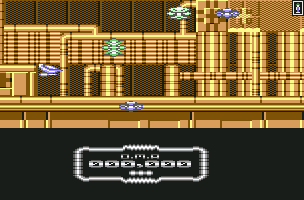
Around February, when Dave discovered I had been booted from college (and once I’d recovered from the beating my mum me), he asked me to come and visit down at his house during the day to keep him company. While I wasn’t there, I was working on his own game; “The Game with no name 7“. This would eventually be renamed to “Talisman“. While it’s a sign of how far it got that it actually got a proper name, the big problem for me was that I had no artists to draw my graphics. So, while I managed to draw my own basic background’s, I ended up pinching sprites from Thalamus’ game “Armalyte“. This allowed me to code the game, and get graphics later, if I actually got that far.
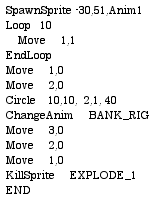
It was coming on quite nicely too, and looked like it may actually get finished. It was a shoot-em-up for the C64, and had a couple of new features in it, the first of which was a new way of moving the aliens around. In Menace, Dave had to enter lots of numbers to control the aliens; My method was far more compact. Dave also quite liked it, so one of the times I was down visiting, I took a printout down with me and read out the 6502 while Dave typed it in converting it on the fly to 68000 . Blood Money is full of complex paths, due almost entirely to my new system.
When Dave did a short interview which was published at the back of the manual, he mentions the new system. And although I moaned about the fact that Dave took credit for it, the 2 way flow of ideas over the years have more or less evened it out by now…

I was currently trying to get into Art college, and to find some direction in my life. My mum was also not happy about me flunking out of college, and was sending me to interviews for various jobs, and trying to get me into the YTS (Youth Training Scheme). She finally forgave me though, right about the same time as I started to earn more than her. I did actually get accepted into Art college for a technical drawing course, and this was to start in the autumn.
However, around April, Dave finally asked if he were to get an office, would I go and work for him. I was ecstatic. To finally become a paid developer was a dream come true! I had actually been programming games at home since I was about 13, starting with a ZX81, and then working my way up through the ZX Spectrum, Commodore Plus/4 and the C64 machines, and I never thought I’d actually manage to become a real games developer.
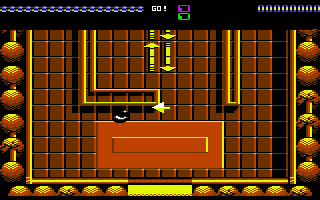
Mum however, wasn’t so pleased. She didn’t see this as a real job, and who could blame her! In 1989, no one wrote games, it was a bedroom hobby, not a full time job. Dave got me some new hardware (a Dolphin Dos system) for my C64 to allow faster development, but it wasn’t as much help as was hoped. It still took a full twenty minutes to build my new game, and much of the time it usually got an error at the end of it. This was just a way of life, and I took to reading the code, and dry running things for about 10 minutes before even try to assemble it.
By using Talisman as a demonstration of my abilities, Dave managed to get Psygnosis to give me my first conversion job; Ballistix for the C64. Dave gave me the news at the computer club one night, along with the main mathematical computations used in the game – a scan of actual bit of paper he got is shown here.

I started to have reservations at this point. The C64’s 1Mhz processor wasn’t good at these things, however, I was still excited about doing a real game, so pondered how to approach it. I also had to come up with a way to draw lots of sprites, and for inspiration, I referred to the set of articles written by the legendary Andrew Brewbrook in ZZap64. It took me a week or so, but afterwords I could now draw 32 sprites rather than the C64’s default 8 – a big step.
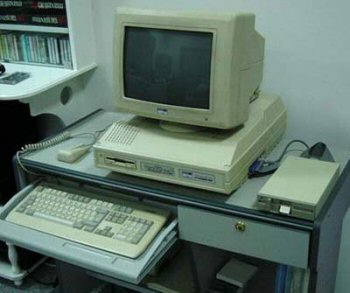
Next I had to address the scrolling, and although this was fairly straight forward on the C64, I did have some problems with the static panel at the top. It was around April/May that I also started to visit Russell’s house during the day to work on Ballistix, even though it involved a 30 minute bike ride. Russell and I, and on occasion Steve (who did the C64 and PC graphics for Ballistix), would all cram themselves into his bedroom, and set about their various tasks.
It was a very odd thing to do…even then. Russell had a single desk in his room, and a chest of drawers. He sat at the desk, then Steve sat with his C64 on a board sitting wedged in a drawer so that we were all sort of staggered, rather than all in a line, otherwise, we wouldn’t have fit!
They went on like this for a couple of months or so, till Dave got me a brand new Amstrad PC2286, 12Mhz PC, with 12″ colour monitor and 20Mb Hard Disk. It came complete with it’s own very own 6502 PDS system. I felt like a pro! Press a button, and the game built in a hart beat! It was attached to a real C64 and would squirt the code over a parallel cable to be run. It even had a professional debugger! A debugger! I’d never had this before, always having to figure out bugs by looking a the source instead.
I transferred the code over to the PC from the C64, which basically meant I had to type it all in again, reading the code from one screen to the other – high tech stuff.

Russell was progressing rapidly with Menace on the PC, but he suddenly discovered a bug. Only the first bullet had any collision, all the rest went straight though the aliens and didn’t hit anything!
What amazed Russell of course, was that the Psygnosis’ testers never spotted it till after the game had shipped, so it’s still there to this day!!
While writing Menace, Russell had started a new program called ILBM2RAW, and over the years, everyone has either expanded it, or written their own. It took a DPaint pictures (.IFF or ILBM files), and cut graphics out for the programmer to use. This was to be a very important program in later years.
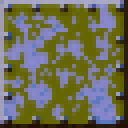
Russell was also playing with the Amiga, and did the usual bouncing colour bars that were common around this time, before doing a cool horizontal spinning block routine, which Dave really liked and so pinched and it was eventually used in the Blood Money title screen.
Russell finished off Menace some time later, and started on the PC port of Ballistix, and I for one was very grateful. DMA had by now gotten the all the source from the ST version (by Reflections), and hoped to get the important routines from it, and then port them to both the PC and C64.
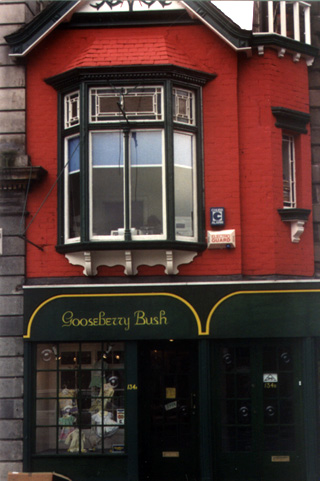
The source code however, was a mess, and I had to clean it up before we all looked though it. I then spent 3 days solid formatting over 13,000 lines of 68000 source code into a readable format, then printing out the whole thing. Russell then set about trying to decipher it all. The printout has since been donated to McManus Galleries in Dundee, along with some other old DMA and Game Dev stuff.
Russell was getting on quite well with it, and they set about doing the hard stuff, Russell on the PC, and me on the C64. Dave meanwhile was sorting the office out. His Father-in-law-to-be owned a chip shop/restaurant in town called the Deep Sea, and also owned a little office across the road from it; an odd red and green building above a baby shop.
We did briefly have a swinging DMA Design sign outside, but if you look closely at the picture, you’ll see a dangling pole just in front of the windows. This sign didn’t last long at all, and after one pretty windy night, we came back to find it gone…..
Dave got the office modernised – eventually, and carried on writing Blood Money. While he was doing the intro, Dave again “borrowed” some of my code. While Brian was at camp in America, he had lent me his Atari ST so I could have a play with it. Aside from playing games like Dungeon Master and Oids, I used the time to learn 68000, and then wrote my first ST demo.

My first demo only took a couple of days and was a rotating star field, with a sinus scroller – a sinus scroller being a scrolling message that twists and bends up and down as it scrolls – like a sine wave! Since Dave was doing a space sequence, he needed a star field for his intro, so I took out the rotating bit, and Dave used that. It wasn’t a very good star field, as there’s no real depth to it, and there’s a flashing white dot right in the middle – but time was short, so Dave used it anyway. You can still see this flashing which pixel if you watch the Blood Money intro sequence….
Come August, the office was finally ready, and we all got ready to move…. We all went back to Russell’s to pick up the equipment, and pack it all away. I however, forgotten to “park” the machines Hard Disk – this was done on early machines to stop the hard disk heads moving during transportation and damaging the drive and it’s data; it’s automatic these days. By the time I remembered, the machine was already in bits, and we were packing it into the back of Dave’s Astra. So when I wanted to plug it all back in, Dave just laughed, and told me not to worry – but I did.
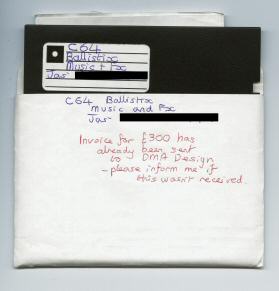
As soon as they moved the machine in and sat it at my desk, I powered it on to make sure it was still running; it was. Needless to say, I was mocked for a while on that one….
Dave also got some music for Ballistix from one Jas.C.Brooke costing £300, the date on the instructions was 24th August 1989. C64 music is very easy to add, so in it went, without a hitch.
While Dave was finishing off Blood Money, Russell brought a friend of his up to the office, Gary Timmons. Gary was fascinated with the animations in Blood Money, and so started to come in to toy with DPaint sitting in the corner next to Dave. He played with the Walker animation that Tony did, and using just dots, managed to replicate the motion of it.
Dave decided to offer Gary a place as an artist, set him up in the back room to play with DPaint. Dave had by now finished Blood Money, and started on Walker (inspired yet again by Tony’s Walker animation). Scott Johnston (Author of Hired Guns) also appeared around this time, he had been working at MacDonald’s for a couple of weeks, so Dave saved him and brought him in freelance to do Walker graphics.
Scott wrote a small 3D program to render the walkers head in the correct positions, and rendered these out to images he could then touch up later in DPaint. Although the basic 3D head looked rough, it was pretty clever, and allowed the movement of the walkers head to be very precise.
It was about this time that Scott showed me his first set of animations for the men that would attack the walker, and it was now that we had the legendary argument that spawned Lemmings, and the famous Lemmings animation.
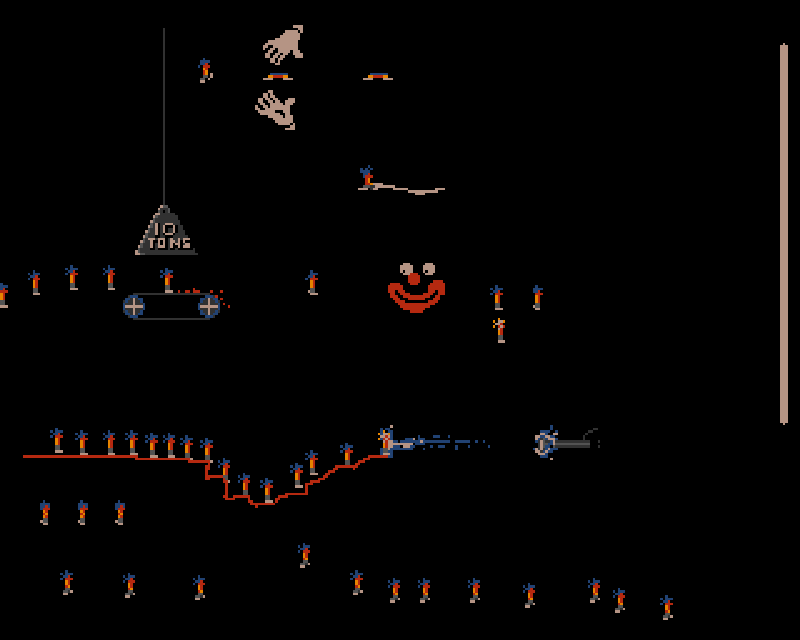
The end of August brought my first paycheck, a stunning amount of £272! My first wage wasn’t that much, in fact at a mere £4000 a year, it’s not surprising that most people thought games were a waste of time. However, when DMA started money was tight, so much so that Dave had to check the bank numerous times on pay day to see if we could get paid at all!
Wages obviously went up once DMA got a bit more financially secure – right about the time Lemmings came out in fact! Gary and I usually had a very long walk every pay day to Dave’s bank to cash the cheques and get our money, but it was all worth it. I was doing his dream job, and getting paid, and since I was still living at home with my mother, it was fairly cheap. And what did I get with my first months wages? A video recorded costing £220, and I still had money left over at the end of the month to live on.
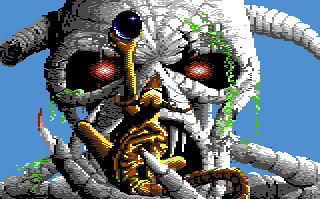
Towards the end of August, Russell also did a really neat addition to ILBM2RAW to convert the ST Ballistix loading screen directly into C64 format. The image was, and still is, very well received by Commodore users, and although I did touch it up a little, it was mostly an automatic procedure, and a very quick result.
It was now September; Gary officially started work, and proceeded to learn DPaint, something he’d spend a lot of time in over the next 10 years…
The final touches complete, I set about making the final Ballistix master on the 1st of September, 1989; that is after another last minute rewrite to increase the mathematics accuracy. The whole thing had been done using 8.8 Maths, but it was very ropy, so after showing a partial test using 8.16 Maths, Psygnosis ask that the rest be converted to give a better result. The game obviously took a hit, but not so you’d notice. I also improved the ball to wall collisions so they were very robust.
The whole team was getting ready to go to Earls Court for the “Personal Computer World” show, so Russell quickly coded a demo of Lemmings to show Psygnosis, and they all arranged cheap hotels, while I stayed with relatives. This was the first show DMA had ever been to, and they was able to visit the Psygnosis stand and see their games on show. I even got a free Psygnosis T-Shirt with “Developer” on the arm. I put it on and strutted around; I was finally a real developer like all these guys I’d been reading about in Zzap64 for years.
It was nerve-racking however, watching the public play our games, they kept waiting for them to crash, or go “funny”. Oddly enough, the show passed without incident – probably for the first and last time ever!
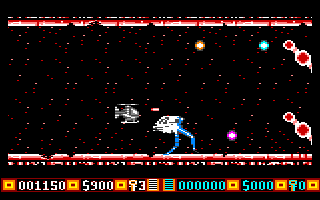
On arriving back, I started a port of Blood Money to the C64 and couldn’t be happier! I’d always wanted to do a shoot-em-up on the C64, and while Ballistix just confused me most of the time, shoot-em-up’s were in my DNA. I took most of the code from the Talisman demo – which was the demo shown to Psygnosis to get the Ballistix contract, as the basis of Blood Money, and started to write a new sprite system; one worthy of my dream project.
Meanwhile Dave was progressing with Walker. He now had a walker wandering over a scrolling grid, with the idea then the Walker would fight its way along, and drop down through holes to the next level. This turned out to be a bit more complicated than he first thought however, and so he sat down to consider how to proceed.
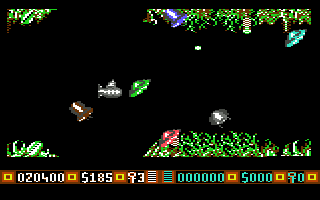
Dave’s then girlfriend (and now wife) Pam would come to visit now and then, and horrified at the state of the office, and more specifically the toilet, would end up cleaning the place from top to bottom. This was usually accompanied by shouting, demanding to know how they could work in a place like this. It didn’t work of course, since they were all far too busy enjoying themselves.
I was progressing with Blood Money, and now had the sprite control system working, along with the multi-directional scrolling. Tony was doing all the graphics this time, and this confused him a bit, since the C64’s graphics are very limited, and he had to get used to doing things in a very odd way. For a start, he had to draw in double pixels in DPaint, which was an odd limit of coloured graphics on the C64. He also only had a choice of 16 very limited colours, but he made great use of them, and Blood Money ended up looking fantastic.
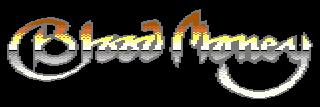
Dave instructed me to learn Pascal so I could do some tools for the C64 on the PC, and gave me Borland Pascal 4 to work with. My only previous high level language was the various Basics on the 8 bit machines, but it didn’t take too long and he soon had the basic tools working. I then set about doing a compression system so I could store more sprites, again inspired by Brewbrook’s ZZap64 articles.
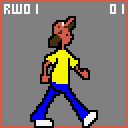
Gary meanwhile had been studying hard, and had produced a Disney style walking character, all 24 frames of it. It featured a skinny boy, in a bright yellow shirt, blue pants, and a cap. This was a lot of frames for a computer game, more than any other at this time. Games tend to use 8 or 16 frames maximum! The other oddity was that the “step” moved the character in blocks of 24 pixels, something very “un-computer” like and something that would cause huge headaches down the line.
Gary’s animation was just too nice to pass up however, so while Dave though of what to do, Gary proceeded with more animations of his new character. Russell was currently busy at Dundee University, so wasn’t around much, but Brian who was still doing the course Dave dropped out of, kept popping in.
Dave had by now realised that Walkers gameplay needed more thought, so put it on hold and he sought something else to work on….
